|
LEGEND OF THE SEVEN LAKES |
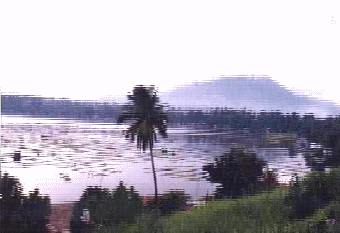 According to a legend, the lake derived its name from a
giant tamarind (sampalok) tree in the garden of a selfish stingy old woman
who drove
away a fairy disguised as an old man asking for some fruit as a cure for
his ailing grandson. Instead of yielding to his appeal for help, the
stingy old woman had him driven away by her ferocious dogs. The old man
was badly hurt.
According to a legend, the lake derived its name from a
giant tamarind (sampalok) tree in the garden of a selfish stingy old woman
who drove
away a fairy disguised as an old man asking for some fruit as a cure for
his ailing grandson. Instead of yielding to his appeal for help, the
stingy old woman had him driven away by her ferocious dogs. The old man
was badly hurt.
Hardly an hour after the old man left, there was a thundering noise followed by the cracking of the earth. The next instant the entire orchard sank into a colossal pit which was eventually filled with water. Henceforth, the villagers called it Lake Sampalok.
The city's biggest and premier lake is located within the city proper. It has an area of 104.0 hectares, a maximum depth of 27.0 meters. Approximately 85% of its volume is of uniform depth. Sampalok Lake is sunk in a shallow depression, revealing its volcanic origin.
Considered one of the prime tourist spots in the city,
Sampalok Lake is dotted with floating restaurants along its shoreline that
serve delectable Filipino and Chinese cuisines. It abounds with tilapia,
bangus, carp and several species of shrimps. It is presently lined with
fish pens and small cottages built on bamboo stilts.
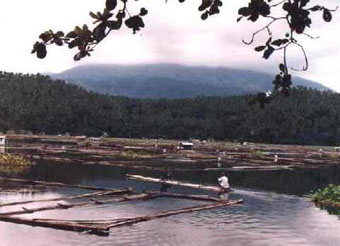 Lake Calibato
Lake Calibato
It appeared that this rich valley used to be the domain of a Diwata who had wanted to keep her realm free from the intrusion of humankind. She did not want her wild game and her fruit trees to be molested by mortal men. Thus she was angered when they built rocky pathways that criss-crossed her valley. She caused a strong earthquake and a severe storm that transformed her valley into a lagoon.
The villagers living on the other side of the surrounding hills, gaping at the sight they beheld the following morning, named it Lake Kalibato, taken from the criss-crossing pathways of the valley. (Kali must have been a conjunction of the Spanish Calle or Street, while Bato means rock or stone.)
A crater lake located in Barangay Sto. Angel, Calibato has an area of 42 hectares and maximum depth of 135 meters. Calibato's greatest volume of water in storage is approximately 29,600 cubic meters.
Calibato supplies the city and nearby towns with abundant fish.
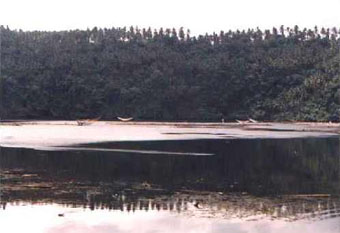
Lake Pandin
Located in Barangay San Lorenzo, Pandin has an area of 20.5 hectares and a maximum depth of 63 meters. It has a calculated volume of 6,600 cubic meters of water in storage.
Pandin is considered oligotrophic because of the abundant plant and fish life.
A very rich couple lived in a beautiful house surrounded by an extensive fruit orchard and flower garden. They had and could have anything that money could buy. However, despite the rich comfort and convenience of life that they inherited, the couple were lonely because they were childless. They had prayed continuously that if they would be favored with a child, they would do anything that they might be asked to do. After twenty years, their prayer was answered.A fairy showed up to inform them that their prayer would be granted provided, however, that the baby to be born should not be allowed to set foot on mother earth; otherwise, something terrible would befall to the family.
A daughter was born to the rejoicing couple, and the girl grew up to be
a beautiful woman. All these years she had never set forth on mother
earth. Then came an ardent suitor at the time when the girl was seing. The
young man invited her to come down the house and promenade with him about
the green orchard, but the girl demurred.
|
Lake Yambo |
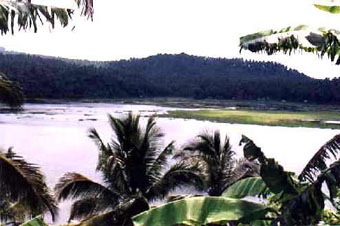 Suddenly the
young man grabbed the ball of thread and threw it out of the window, and
would not listen to the pleadings of the girl to retrieve the ball for she
could not get it herself. Angrily, the girl forgot her parents'
instructions and got out of the house to get back her ball of thread. She
hardly stepped on mother earth when a terrible noise followed by the
cracking grumble of the earth and the heavy downpour eventually converted
the huge orchard into twin lagoons separated from each other by a bare
strip of land.
Suddenly the
young man grabbed the ball of thread and threw it out of the window, and
would not listen to the pleadings of the girl to retrieve the ball for she
could not get it herself. Angrily, the girl forgot her parents'
instructions and got out of the house to get back her ball of thread. She
hardly stepped on mother earth when a terrible noise followed by the
cracking grumble of the earth and the heavy downpour eventually converted
the huge orchard into twin lagoons separated from each other by a bare
strip of land.
Learning about the sorry fate of the two lovers, the people of the nearby villages named one lagoon after the girl who was Pandin, and the other after the boy's name Yambo.
Barangay San Lorenzo also has Yambo Lake. Yambo is adjacent to Pandin Lake. It has a normal surface area of 28.5 hectares.
Yambo, like Pandin is considered oligotropic, and is suitable for swimming, outings and picnics.
 Lake Bunot
Lake Bunot
Into the course of their routine patrol work, some Spanish soldiers came upon a quiet lagoon and wanted to know its name for record purposes. They inquired from a man husking coconuts by the side of the lake. Thinking that the soldiers were asking for the native name of the coconut husk, the man replied: "Bunot."
The Spanish soldiers left, muttering the word "Bunot, Bunot," thinking that it was the name of their newly-discovered lake.
Only 4.5 kms. from the city proper, Bunot is known for its cultured tilapia and fishpens for Nilotica fingerlings. Bunot has a normal surface area of 30.5 hectares with a maximum depth of 23 meters.
Bunot is a convenient site for picnics. It is a real
haven for nature lovers. Ideal for swimming amd
relaxation.
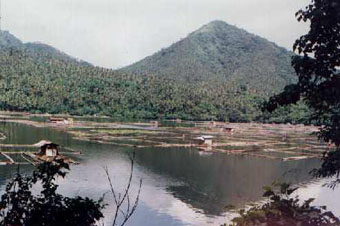 Lake
Muhikap
Lake
Muhikap
The story of Lake Muhikap is akin to the legend of Lake Pandin and Lake Yambo. It tells about the couple who had a very sickly daughter named Munica. The couple were both very religious and they kept praying to god for the good health of their only child. They made a promise to do anything if God would answer their prayer. God granted their prayer on condition that Munica must not set foot on mother earth.
One day while Munica was sewing her dress, the ball of thread she was using fell to the ground. Her parents were not around to retrieve it, so Munica recovered the ball by herself. While doing so, she fainted and immediately fell into the ground. She suddenly sank with the entire neighborhood, and a lagoon was formed. This body of water was later called Muhikap in honor of the unfortunate but very industrious girl. The name of the lake was taken from Munica, the girl's name, and Mahikap meaning industrious.
Located in Barangay Sta. Catalina, Mohicap Lake is a 14.5 hectare-lake. It is one of the main suppliers of water resources in the city. Its waters provide a generous source of tilapia for Metro Manila and suburbs.
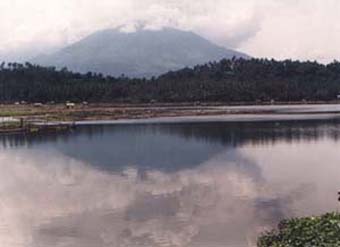 Lake Palakpakin
Lake Palakpakin
A few kilometers north of the city proper was a village which had become known then for its ancient tree which had a hollow trunk. The villagers had had it that on moonlight nights they could see a beautiful, re-haired lady washing her long hair with the hollow trunk serving as her wash basin. The tree was called Palakpak. There was also a river nearby where a big fish appeared each night that the beautiful lady was around. The villagers would not catch it, believing that it must be her pet.
One day a stranger came to the village. He tried to solve the mystery about the red-haired lady and the big fish. And so one moonlit night, he waited for her appearance. Seeing the lady in her pristine glory, the stranger approached her. All of a sudden there was thunder and lightning. The earth quaked with terrible intensity, while the river swelled alarmingly into a lake.
Both the beautiful lady and the big fish were gone, but in their place was a lake that nurtured a large quantity of shrimps which when cooked turned red. The material well-being of the villagers having been uplifted, they since then had affectionately called their village "Palakpakin," and their principal source of livelihood, Hipong Palakpakin.
Palakpakin Lake in Brgy. San Buenaventura is similar to Sampalok Lake. With an area of 43 hectares, it has a maximum depth of 7.5 meters.
Residents around the lake rely on income from fish pens and fish cages that grow cultured tilapia and silver carps.
|
Copyright © 2002 Seven Lakes (San Pablo City) International All rights reserved. This
web site was designed and being maintained by Viz-Mart
Int'l. Computers. For comments or suggestions, please send e-mail
to EngrVV@aol.com. |